Structural Geology of Anglesey, 12 -
13 August 2006
We had heard Sue Treagus talk about the Rhoscolyn Anticline and (and tried to digest) the copy of the paper she, Jack and Giles published in 2003. Now we were ready to see the geology in the field. This two day trip, in glorious weather, led by Giles, did not disappoint.
We started at Rhosneigr where Giles provided us with excellent field notes which included maps of the geology both regional (Anglesey) and local (Rhoscolyn) together with a copy of the section through the Anticline, annotated with our field locations. Giles started by explaining what we would be seeing: mainly the late Pre-Cambrian/early Cambrian Monian Supergroup but commencing with a look at the Ordovician rocks overlying the Monian.
These outcropped at Rhosneigr seafront and showed Caledonian deformation. They were laid down the margins of the Iapetus Ocean which closed during the Silurian. We saw black slates with well developed sub-vertical penetrative cleavage. Bedding could be found in sandstone beds although it wasn't that easy to find or see. Both these and the organic rich muds had been folded with the maximum stress perpendicular to cleavage. There were also examples of differential folding demonstrating the differences in competencies of the rock types. Because of the high tide, we were unable to see the basal conglomerates which was a shame because they sounded very interesting, containing a variety of clasts such as cleaved phyllite and vein quartz.
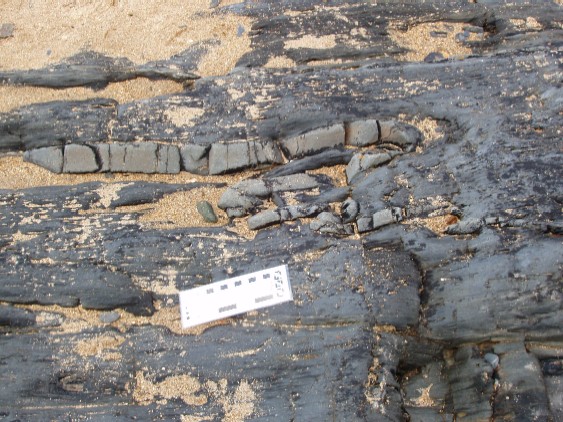
Folds at Rhosneigr - Mary Howie
The afternoon was spent in and around Borth Wen, a small bay to the south east of Rhoscolyn village. Here Giles outlined the general succession: South Stack Formation (oldest Monian Supergroup), Holyhead Quartzite, Rhoscolyn Beds (youngest Monian Supergroup) and the overlying New Harbour Group. Ageing the rocks was difficult as there was minimal fossil evidence but the Rhoscolyn as mentioned above does seem to be (Pre)Cambrian.
Giles also explained that we were on the SE limb of the Rhoscolyn anticline and as we were to see over the rest of our trip, there has been a great deal of deformation: two phases. Whether the anticline itself is first or second phase is not clear. There is much deliberation about within Manchester University and Giles said that he would show us some of the evidence which makes him consider the anticline first phase (F1) rather than second (F2).
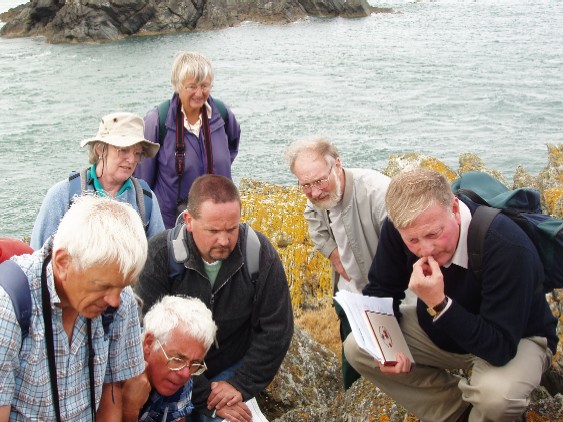
F1 or F2 - which is it? - Mary Howie
The tide had receded sufficiently for us to see the psammites of the Rhoscolyn outcropping on the shore. These rocks had been 'cooked' at about 400oC. We also found a lens of conglomerate which might represent a channel feature. Moving further round this small bay, we found greenish rocks (due to chlorite) which contained some mafic detritus (possibly due to volcanic activity).
The cliffs at the SW side of Borth Wen were generally New Harbour rocks: very greenish, very contorted. There was a surface schistosity with stretching lineation in quartz partings apparent. The tight chevron folds bent the mica-chlorite cleavage indicating that they were not the first deformation of the rocks. These rocks were an amazing sight. The contact between the New Harbour and Rhoscolyn rocks went through the area (covered by the water) and to see the contact better, we moved over a small headland.
It has been suggested that the contact between the two may be a fault but we found no evidence to suggest this. In fact the two rock types appeared conformable although there was quite complex zone between them. This comprised a 4-5m greenschist zone and in particular there was a volcanic ash horizon.
We then started our coastal walk through the Rhoscolyn Anticline, starting on the SE limb and which would take us during the rest of our trip through the Monian Supergroup rocks, finishing eventually back with the New Harbour Group.
The Rhoscolyn rocks are a mixture of psammites, pelites and some quartzites. There is some graded bedding although we did have trouble finding any. The psammites were originally greywackes and are green or grey when fresh.
At our first location on the coast near Porth yr Hwngan, the psammite beds were dipping quite steeply (usually NW) with an almost vertical cleavage which was axial planar to the folds. These large folds belonged to the first deformation and will now be referred to as F1 . As we walked further, we came across asymmetric fold pairs picked out by a green grassy gully which we learnt to recognize as a weathered pelite bed, in this case about 2m thick.
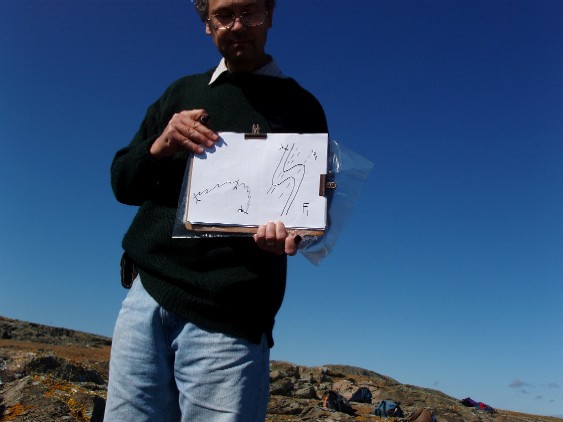
Giles explains - Mary Howie
Our final location on the first day had more pelite beds. These were well weathered with a strong first cleavage (S1 ) and full of contorted quartz veins which followed the S1 cleavage. We saw cleavage refraction at the psammite/pelite contact. The S1 cleavage has been folded by F2 deformation and these second generation folds did have a second cleavage which was axial planar to the F2 folds. This only affected the pelite. The cleavage in the psammite was too flat to pick up the later folds.
Discussion followed about the source of the quartz. Giles said that no one was really sure. It could come from the mudstones (now pelites) as a result of deformation or possibly within hydrothermal fluids, although this was considered less likely.
After an enjoyable stay at Bangor University, despite arriving in the middle of a false fire alarm, we were back at Rhoscolyn early on Day 2 to continue our walk through the Anticline.
We started at the base of a very prominent 'cliff' of quartzite. This was the top surface of the Holyhead Quartzite. The adjoining beds were of pelite which had been weathered to form deep and steep gully. The quartzite was very interesting as it had picked up the first cleavage but it was anastomosing (branching). In parts it was also affected by a later deformation (of indeterminate age) which manifested itself as a small 'kink' in a totally 'foreign' direction.
We climbed up via a grassy slope to the coastguard hut where Giles explained that these grassy tracks were the surface manifestation of pelite beds. From the hut, we could see a gorse-covered ridge which was quartzite. The trend was now NW: we had passed over the hinge of the main anticline. The quartzite outcrop contained some chlorite and muscovite mica. We could not find any bedding and Giles confirmed that the bedding was probably never there in the first place. Several deep gullies were evident and these were caused by faulting.
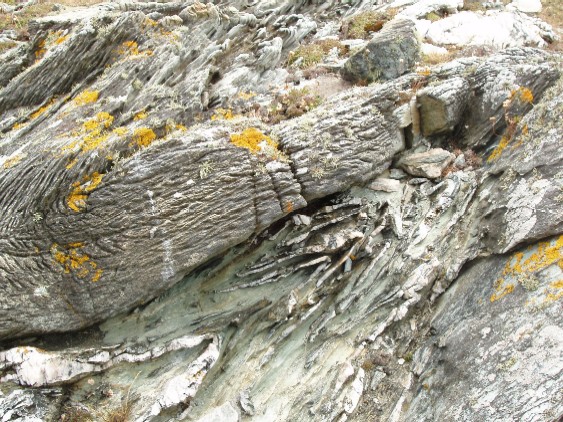
Big folds and little folds on Rhoscolyn Head - Mary Howie
After negotiating round one of these gullies, we arrived on a promontory where we could look back at the cliffs. The sight was amazing.
The base of the Holyhead Quartzite was lobate over a pelite band at the top of the South Stack formation. We could see wonderful folding at various scales: large 'M'-shaped relatively gentle folds (which indicated we were near the core of the main Anticline) plus much more chevron-like ones picked out by the different colours of the beds with 'S'- shapes.
The rocks on which we stood also had evidence of folding from both deformations. F1 bent the bedding only whilst F2 bend the S1 cleavage too. We saw examples of F1 folds being rolled or re-opened by F2 . Giles kindly spent part of our lunch break explaining how the folds were reopened. Gradually, through the use of pen and paper and 'thought experiments' on our part, I think we understood what was happening.
The afternoon brought more examples of F1 and F2 folding with S1 cleavages being folded and new S2 cleavages forming. We saw some examples of crenulation cleavages whilst risking life and limb to clamber over steeply dipping beds of quartzite and psammite. We also saw the tartan-like result of S1 and S2 cleavages being superimposed on one another. The change from 'Z' to 'S' folds was obvious confirming that we had passed over the hinge of the anticline. We moved from the South Stack formation back into the Rhoscolyn beds and saw more quartzite than previously.
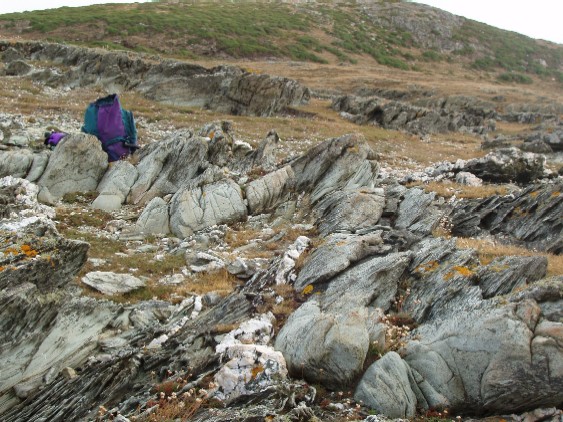
More big folds! - Mary Howie
We also came across some sedimentary structures: slump folding and dewatering structures. Towards the north west of the section, we saw more examples of faulting – the same faults as we had already seen but the sea inlets formed appeared more obvious. A couple of arches have been formed near Bwa Du– one obvious and one not obvious even when standing on top of it.
At one of the last locations, we could actually stand on the fault zone which was between 1 and 2 m wide. Here we were back with the New Harbour formation and the cliff was full of refolded folds. This was one location where the contact between the Rhoscolyn and New Harbour formations was tectonic. Our final stop gave us another, clearer opportunity to see stretching lineation and chevron folding, and to collect hand specimens showing some of the structural features we had seen over the weekend.
Having spent two days 'getting our heads round' the structural geology and 'our legs' up and down some 'interesting' slopes, it was a tired but happy group which returned to Rhoscolyn church to thank Giles for a really wonderful trip.
Jane Michael
**************************************





